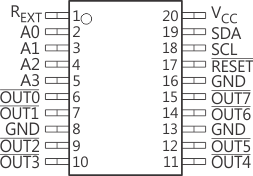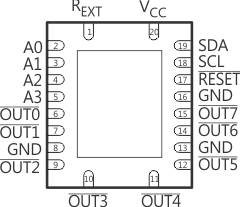SLDS156B March 2009 – July 2015 TLC59108
PRODUCTION DATA.
- 1 Features
- 2 Applications
- 3 Description
- 4 Revision History
- 5 Description (continued)
- 6 Pin Configuration and Functions
- 7 Specifications
- 8 Parameter Measurement Information
-
9 Detailed Description
- 9.1 Overview
- 9.2 Functional Block Diagram
- 9.3 Feature Description
- 9.4 Device Functional Modes
- 9.5 Programming
- 9.6
Register Maps
- 9.6.1
Register Descriptions
- 9.6.1.1 Mode Register 1 (MODE1)
- 9.6.1.2 Mode Register 2 (MODE2)
- 9.6.1.3 Brightness Control Registers 0 to 7 (PWM0 to PWM7)
- 9.6.1.4 Group Duty Cycle Control Register (GRPPWM)
- 9.6.1.5 Group Frequency Register (GRPFREQ)
- 9.6.1.6 LED Driver Output State Registers (LEDOUT0, LEDOUT1)
- 9.6.1.7 I2C Bus Subaddress Registers 1 to 3 (SUBADR1 to SUBADR3)
- 9.6.1.8 LED All Call I2C Bus Address Register (ALLCALLADR)
- 9.6.1.9 Output Gain Control Register (IREF)
- 9.6.1.10 Error Flags Registers (EFLAG)
- 9.6.1
Register Descriptions
- 10Application and Implementation
- 11Power Supply Recommendations
- 12Layout
- 13Device and Documentation Support
- 14Mechanical, Packaging, and Orderable Information
封装选项
机械数据 (封装 | 引脚)
散热焊盘机械数据 (封装 | 引脚)
- RGY|20
订购信息
6 Pin Configuration and Functions
PW Package
20-Pin TSSOP
(Top View)

RGY Package
20-Pin VQFN With Thermal Pad
(Top View)

Pin Functions
| PIN | I/O (1) | DESCRIPTION | |
|---|---|---|---|
| NAME | NO. | ||
| A0 | 2 | I | Address input 0 |
| A1 | 3 | I | Address input 1 |
| A2 | 4 | I | Address input 2 |
| A3 | 5 | I | Address input 3 |
| GND | 8, 13, 16 | – | Ground |
| OUT0 | 6 | O | Constant current output 0, LED on at low |
| OUT1 | 7 | O | Constant current output 1, LED on at low |
| OUT2 | 9 | O | Constant current output 2, LED on at low |
| OUT3 | 10 | O | Constant current output 3, LED on at low |
| OUT4 | 11 | O | Constant current output 4, LED on at low |
| OUT5 | 12 | O | Constant current output 5, LED on at low |
| OUT6 | 14 | O | Constant current output 6, LED on at low |
| OUT7 | 15 | O | Constant current output 7, LED on at low |
| RESET | 17 | I | Active-low reset input |
| REXT | 1 | – | Input terminal used to connect an external resistor for setting up all output currents |
| SCL | 18 | I | Serial clock input |
| SDA | 19 | I/O | Serial data input/output |
| VCC | 20 | – | Power supply |
(1) I = input, O = output